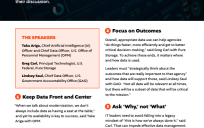This blog post is an excerpt from GovLoop’s recent guide, “Putting Data Analytics at the Forefront of Your Agency.”
It’s no longer a question of whether data should be used to inform decisions in government. Agency leaders know that the massive amounts of information generated by business operations, employees and citizens can’t be ignored if organizations are going to truly meet their missions. The question now is how to make the most of the information, and turn it into insights in a timely fashion.
“Government organizations are working toward their core mission” said Jake Freivald, Vice President at Information Builders. “But right now, they’re having a hard time doing more than just basic reporting.”
In an interview with GovLoop, Freivald explained that many agencies lack the tools and processes to dive into their disparate data and form better insights. Information Builders addresses this issue, providing a suite of technologies to help organizations access, integrate and understand their data.
For many agencies, the main roadblock to data analytics is a technical one. Data often lies in many different systems, in various formats. Because most government organizations continue to rely on legacy systems, it’s difficult to marry that data to analyze it in a consistent manner. Agencies also usually lack the resources to completely overhaul their IT infrastructures to create a more coherent data environment.
For those agencies, a software solution that can consolidate disparate data from various sources without changing the underlying infrastructure is the best solution. Tools like Information Builder’s analytics and data management platform can leverage data from across an enterprise and make it accessible in one location.
Of course, many agency leaders will also point to a lack of data knowledge and skills within the workforce as a primary obstacle to robust analytics. However, Freivald explained that the right technology can help mitigate this challenge. The right data analytics platform will present consolidated data in visual formats that allow users to quickly digest information and generate insights.
“Being able to standardize and reconcile different data sources is important,” he said. “But you also want a tool that brings that data together in a form that is usable to a large number of people, or even the public, without having to train and license them to use these tools.”
However, finding the right tool is only one step towards better data analytics. The second step is to use those tools to gradually expand access to an agency’s data. Information Builders calls this a progressive approach to analytics and data management. Selecting tools that can be incrementally invested in as you need more capability is extremely important as well.
“You really want to get started with the data that you have,” he said. “If you can use one data source and create a dashboard that people actually use, then they will come back for more. Then you can start building in new parameters within the applications you’ve built to create additional value.”
Freivald explained that the ultimate goal for most data programs is predictive analytics – the most advanced and informative type of data analytics. However, newcomers to analytics should start with data applications that are easier to accomplish and grow from there.
The state of Louisiana’s Department of Children and Family Services’ program to curb fraud is a prime example of this progressive approach to data analytics. The department already had reporting mechanisms in place that were supposed to allow them to detect fraud in the Supplemental Nutrition Assistance Program (SNAP). However, the reports were difficult to consume.
Using Information Builder’s platform, the department was able to integrate multiple data sources to better understand where, how and why fraud was occurring without having to manually compare and correlate reports. Incorporating mapping technology into the solution made it much easier to consume insights into where fraud was likely occurring. That allowed the department to more effectively counter fraud and abuse of the program, while saving them time, money, and employee productivity.
But that was only the first step for Louisiana’s application. Using that initial data, the department realized they could also generate other insights about SNAP, including how people were using the program to save money and what further resources they could provide to legitimate users. Now, they’re using their model to help other departments provide similar insights into their areas of business.
“Louisiana is integrating large data sources across multiple parts of the organization to get a single view of the citizen so they can do more for their citizens to provide better service and prevent fraud more effectively,” Freivald said.
That’s the power of progressive analytics. By installing the right tools, starting small, and adding additional functionality over time, organizations can make a big impact on the way government serves citizens.






Leave a Reply
You must be logged in to post a comment.